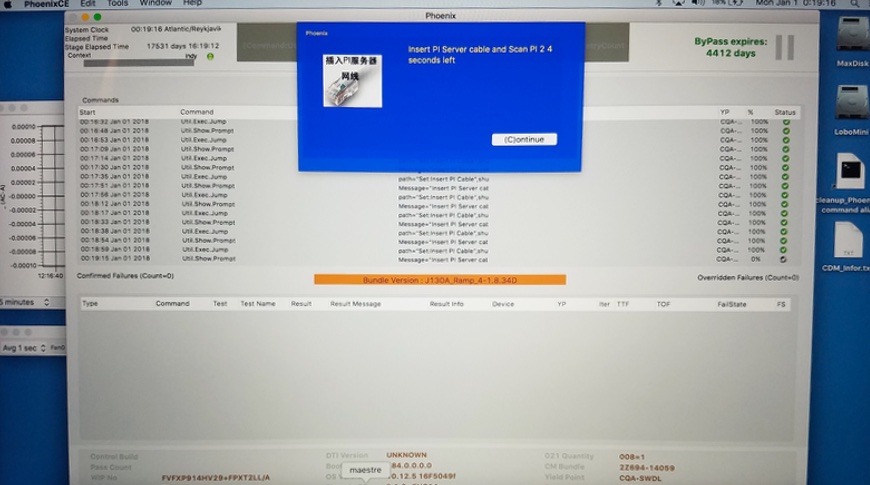

- Apple service diagnostic dmg external hdd how to#
- Apple service diagnostic dmg external hdd install#
- Apple service diagnostic dmg external hdd download#
- Apple service diagnostic dmg external hdd mac#
Apple service diagnostic dmg external hdd install#
You’d have to install MacOS and TechTool Pro on an external USB or Thunderbolt drive, boot from that drive, and they open TechTool Pro to run it on the internal drive. It supports all recent versions of MacOS, as well as all the varying disk formats Apple has used over time. My favorite is TechTool Pro, available at. Replyĭisk Utility, the built-in diagnostic and repair utility in MacOS fixes a lot of things, but there are much deeper diagnostic and repair utilities available from third parties. If that doesn’t resolve the issue, you may need to use a third party utility like TechTool Pro to repair your disk. At that point, quit from Disk Utility and restart your Mac…and see if it’s working. At the end, the Disk Utility window will either say your disk was OK or that the file system was modified. Disk Utility will scan your drive and repair any directory damage as long as it’s not beyond its capabilities. Click to select your internal drive in the left column, then click the First Aid button to run Disk Utility (which runs pretty much the same directory checks as fsck does). When you get to the desktop, you’ll see the MacOS Utilities window, which includes four options:ĭouble-click on Disk Utility. You will see the Apple on the screen, and the boot process will take longer than usual. Instead of booting into Single User Mode (by holding down Command – S on the keyboard, boot into the Apple Recovery Disk by holding down Command – R when booting up. If you continue to have a problem, you can contact us at or 91. If you double-click on Disk Utility, the standard Disk Utility window will open and you can both verify and repair the disk. There will be four choices in the Window: Restore from Time Machine Backup, Reinstall macOS, Get Help Online, and Disk Utility.

Booting up will be slower than usual, but you should end up at a desktop screen with a MacOS Utilities window. Turn it on and press and hold Command – R on the keyboard. If that doesn’t work, you can also try booting into the Recovery Disk, which works on any MacOS version 10.7 or later. That sometimes adds a couple of lines, and the last line has the /root prompt. If that doesn’t work, once the screen has gotten down to its last line and it doesn’t seem it add any new lines, just press the Return/Enter button on the keyboard. Some Macs load single user mode slower than others.
Apple service diagnostic dmg external hdd mac#
Or you have a newer Mac with firmware that can talk to Apple directly (pretty much anything 2010 and newer) over the internet.Presuming you are at least getting the black screen with white lettering, it may be that you need to wait a bit longer. So the gist is, once you've lost the installed version of AHT, you either need the AHT disk that came with your computer or buy one from Apple or go to an Apple store and they'll run it for you.
Apple service diagnostic dmg external hdd download#
It doesn't permanently download this to disk, the firmware downloads and runs it, and upon reboot it's gone again. Since install disks are gone, I don't actually know how current Mac owners are supposed to get this restored, however also since that time, Apple has moved to firmware that can load the proper version of AHT via option-D on boot with a wired or wireless internet connection. So it can still be used when FV2 encryption is enabled. With 10.7 and newer hardware, the AHT is stuffed into an AHTxx.dmg file and found on the Recovery HD volume, also in a hidden directory.

And if you encrypt the drive with File Vault 2 it would be unavailable in any case. If you reformat the drive and reinstall, this is not reinstalled.
What I've learned is that pretty much all intel Macs before 10.7 did have AHT preloaded on the drive, found in hidden folder /System/Library/CoreServices/.dianostics.
Apple service diagnostic dmg external hdd how to#
Unfortunately Apple simply doesn't make it easy to figure out how to restore this. A pile of them are available for download but are obscured behind a non-obvious naming convention. Every Mac model has its own components different than any other, and the Apple Hardware Test is unique to each model.


 0 kommentar(er)
0 kommentar(er)
